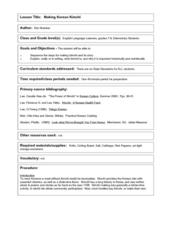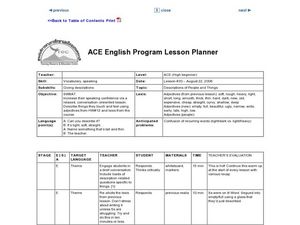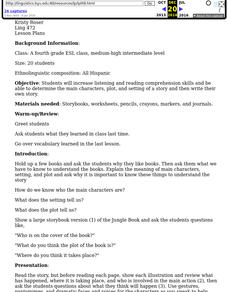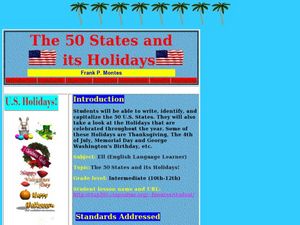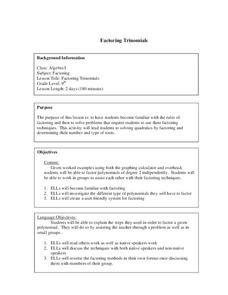Curated OER
Have You Seen Jack?
Students study relative clauses and appositives. In this ESL instructional activity, students role play. Students use relatives clauses and appositives to describe people. Students use dialogue.
Curated OER
Moccasins Are Made for Dancing
Young scholars explore two Native American legends. For this cultural traditions lesson, students read "The Legend of Blue Bonnet," and "The Legend of the Indian Paintbrush." Young scholars then study basic Native American dance...
Curated OER
Making Korean Kimchi
Students make Korean Kimchi. In this Korean culture lesson, students follow the steps for making kimchi and learn about its background.
Curated OER
A World of Myths
Students read and write myths. In this world mythology lesson, students read and analyze myths from various cultures and then recognize their attributes as they write their own myths to explain natural phenomena.
Curated OER
Disc/Washer Method
Students calculate the volume of solids. In this calculus lesson, students apply the Disk and Washer Method to solve for the volume of three dimensional objects. They calculate the volume caused by rotation that create...
Curated OER
Discovery Research of Quadratics
Students investigate the properties behind the quadratic equation. In this algebra instructional activity, students identify quadratic equation in the real world. They graph the parabola and identify the vertex and intercepts.
Curated OER
Representation of Quadratic Functions
Students use a table, graph or equation to represent a quadratic function. In this algebra lesson, students model and graph with quadratic function. They become comfortable representing quadratics using different methods.
Curated OER
Rolling with Links
First graders explore geometry by completing a worksheet in class. In this non-standard measurement unit lesson, 1st graders discuss different techniques for measuring items without the use of a ruler. Students read several short stories...
Curated OER
Formulas for Volume and Surface Area
Students calculate the volume and surface area of each shape. In this geometry lesson, students use nets and other three dimensional polygons to create visuals of the volume of a shape. They define important vocabulary words...
Curated OER
Where in the United States Are We?
Students spend the lesson identifying the location of the fifty states and the capitals. Using a software program, they retrace te outline of each state numerous times. To end the lesson, they write a story about a state and city of...
Curated OER
Say and Spell Long Vowel Bossy E Board Game
Students practice saying and spelling long vowel "bossy E" words. In this spelling lesson, students play a board game that requires them to look at a picture, say and spell the word. The first person to the end wins.
Curated OER
Civil Rights/Segregation
Sixth graders investigate Civil Rights by participating in role-playing activities. In this U.S. History instructional activity, 6th graders research the history of slavery in order to portray a story through their debating and...
Curated OER
One Story, Many Tales
Students compare and contrast Cinderella stories. In this folktale lesson plan, students discuss the attributes of the genre and then read and research different cultural versions of the tale. Students present their findings to their...
Curated OER
Exploring Media Messages
This lesson uses discussion and activity to help students explore how advertising and the media affect self-image. Students will learn how to recognize how advertising exploits young people.
Curated OER
Santa Claus Around the World
Students investigate how students in various countries celebrate their winter holiday traditions, locate various countries on a map, and draw and tell about various Santa Claus legends.
EngageNY
What Is a Trigonometric Identity?
Protect yourself from identity theft! Establishing a strong understanding of the Pythagorean identity allows learners to prove that sine^2x + cos^2x = 1. They then use the identity to find sine or cosine ratios given the other.
National Endowment for the Humanities
Life Before the Civil War
American life before the Civil War was very different from American life today. To show this difference in a full spectrum, learners compare two communities that illustrate the differences between Northern and Southern life. Throughout...
Macmillan Education
Networking
"It's not what you know, it's who you know." Learners discuss and analyze this age-old adage by completing life skills worksheets, collaborative activities, and discussions regarding the nature of networking and how it may improve future...
National Endowment for the Humanities
Women's Lives Before the Civil War
Women's lifestyles before the Civil War made a huge impact as a point of causation. Give middle schoolers the opportunity to view firsthand the lives of women before the Civil War. They analyze primary source documents, view photographs,...
Curated OER
Description of People and Things
Elementary schoolers use adjectives correctly in their speech. They demonstrate adjectives using familiar objects. (For example, they might show narrow by walking between two chairs placed closely together.) Then they play antonym Bingo...
Curated OER
Language Practice
The simple instructional techniques described in this plan will help young readers learn and practice basic reading skills and strategies. Before reading, introduce your readers to the meaning of main character, setting, and plot. Then...
Curated OER
The 50 States and its Holidays
Though the format of this ELL lesson is confusing (the standards listed are for plate tectonics, yet the objectives are for American geography and holidays), a teacher could glean some ideas from the main idea. Here, pupils complete a...
Curated OER
Geometric Figures-Triangles
Fourth graders explore triangles. In this math activity, 4th graders discuss the different types of triangles. Students create triangles using wiki sticks. Students complete an online matching game.
Curated OER
Factoring Trinomials
Students factor trinomials correctly. In this algebra activity, students review the rules for factoring trinomials. They factor different polynomials as they relate the same concept and idea to facoring trinomials.




